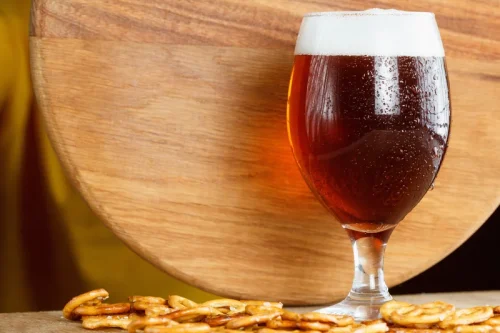Alcohol and High Blood Pressure: Effects and More, Explained
A research review from 2022 analyzed studies that gave participants with hypertension 70–250 milliliters (mL) of beetroot juice per day for 3–60 days. “If you have high blood pressure, it’s probably in your best interest to drink minimally,” Morledge said. Alcohol also stimulates the release https://ecosoberhouse.com/ of adrenaline and puts the body in a fight-or-flight mode, leading to elevated blood pressure. Alcohol consumption is categorized into different levels based on the amount consumed. Here is how drinking levels are defined according to the National Institute on Alcohol Abuse and Alcoholism.
- This is known to provide a good approximation of the SD of change in BP so is unlikely to lead to bias.
- Similarly, when blood pressure increases, these receptors increase the stretching of the blood vessel walls in order to decrease blood pressure.
- In the case of detection bias, we classified nine studies as having low risk of performance bias (Agewall 2000; Bau 2005; Bau 2011; Cheyne 2004; Dai 2002; Karatzi 2013; Narkiewicz 2000; Rosito 1999; Van De Borne 1997).
- After ≥ 13 hours of consumption, SBP and DBP were raised; the certainty of evidence was low and medium, respectively.
Plus, get a FREE copy of the Best Diets for Cognitive Fitness.
We tested the effect of cross‐over trials through sensitivity analysis by excluding them from the meta‐analysis to check if the effect estimate changed significantly. Two review authors (ST and CT) performed data extraction independently using a standard data collection form, followed by a cross‐check. In cases of disagreement, the third review authors (JMW) became involved to resolve how does alcohol affect blood pressure the disagreement. When necessary, we contacted the authors of studies for information about unclear study design. All extracted data were entered and double‐checked in RevMan 5.3 software (Review Manager (RevMan)). Randomised controlled trials (RCTs) comparing effects of a single dose of alcohol versus placebo on blood pressure (BP) or heart rate (HR) in adults (≥ 18 years of age).
Description of studies

This combination of higher fluid levels in the body and smaller blood vessels increases blood pressure. Excessive alcohol consumption can increase the risk of several metabolic conditions, including high blood pressure. Your healthcare provider may recommend a blood pressure medication as well. If you continue to drink, alcohol may reduce the effectiveness of these medications or even cause a serious medical interaction.
Moreira 1998 published data only
Most of all, if your child has high blood pressure, know that you aren’t alone and there are things you can do to treat it. “We recommend using a blood pressure cuff that fits around the right arm, not the wrist, to obtain the most accurate reading,” Dr. Sing says. The bottom line is that if your child is diagnosed with high blood pressure, you should take it seriously. You may think high blood pressure is just an adult problem, but kids can have it too. “I see many men and women in this category in my clinic,” Dr. Max Pemberton wrote Sunday in the Daily Mail. By Adrienne DellwoDellwo was diagnosed with fibromyalgia in 2006 and has over 25 years of experience in health research and writing.
- But lifestyle changes play a vital role in treating high blood pressure.
- A 2023 report found that drinking too much alcohol regularly, exceeding 30 grams per day, can significantly increase the risk of developing high blood pressure.
- In the case of registration at clinical trials.gov, we considered only one study to have low risk of bias (Barden 2013).
- The reason for exclusion was documented for each citation at the full‐text level.
Because all of our outcomes of interest provided continuous data, we used the inverse variance approach and a fixed‐effect model to combine effect sizes across studies. We are moderately certain that medium‐dose alcohol decreased blood pressure and increased heart rate within six hours of consumption. We did not see any significant change in blood pressure or heart rate after that, but the evidence was limited.
- According to the World Health Organization (WHO), around 2.3 billion people globally drink alcohol, and most of them are from the European region.
- Some studies suggest low amounts of alcohol may provide health benefits.
- Regular visits with a healthcare professional also are key to controlling blood pressure.
- You can reduce hypertension by reducing your alcohol intake and following the treatment plan that your doctor recommends.
- This puts a strain on your arteries and your heart, which in turn increases your risk of a heart attack, a stroke or of suffering from kidney disease.
- However, isometric training appears to offer significant blood pressure benefits and can be done safely by people with mobility challenges or who have had a recent injury or surgery.

Researchers found this group had a reduced risk of hypertension after drinking 30 grams, about 2 tablespoons, of a specific form of aged white wine every day for 3 weeks. When the SNS gets activated by alcohol, it can increase heart rates and constrict blood vessels. Prolonged activation of the SNS can contribute to health issues like high blood pressure. “A variety of chronic medical conditions can cause hypertension in children (i.e. renal disease, endocrine disease, heart disease, etc.), and these are commonly treated with medications,” Dr. Gonzalez says. However, he notes, that most cases of high blood pressure in kids are caused by primary or idiopathic hypertension.

Heart Health
We believe that inclusion of those studies will provide useful information about the dose‐related magnitude and time‐course effect of alcohol on blood pressure in people with both normal and elevated blood pressure. Medium‐dose alcohol decreased systolic blood pressure (SBP) by 5.6 mmHg and diastolic blood pressure (DBP) by 4 mmHg within the first six hours of consumption. Hypertension can be genetic or may be due to environmental factors such as poor diet, obesity, tobacco use, excessive alcohol consumption, and sedentary lifestyle (Weber 2014; WHO 2013).

Sierksma 2002 published data only

